
|
Reproduction Ancient Roman Oil Lamps
Roman Empire
The replica ancient oil
lamps in this section represent clay lamps used during height of the
Roman Empire, from the 1st to about the 3rd centuries AD. Many of
these lamps are
molded directly from original Roman lamps. Others are made by
carving Roman style motifs into the Roman-style gypsum molds, while
still using a lamp body copied from an original Roman lamp. These
reproduction Roman lamps can be
used with olive oil like the originals.
Sales will resume in 2025.

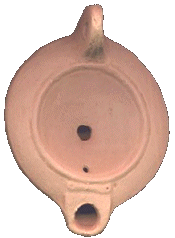 |
LONDINIUM
Circa AD 50 to 150
This undecorated Roman lamp is
named after a nearly
identical found in Roman
London
in the vicinity of the Thames. The original
lamp this was
molded from, as well as the one from the Thames, were both probably
made in northern Italy and imported. This lamp would date to the mid
or late 1st century AD through the 2nd century AD.
Molded directly from the
original.
(about 2.75" x 3.75")
|

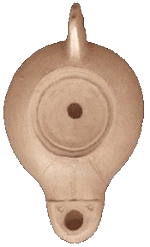 |
GAUL
Circa 1st to 2nd
Century AD
This type of oil
lamp is called a firmalampen, which essentially
means "factory lamp." These lamps were made in large quantities in lamp
workshops all over the Roman empire, but most especially in northern
Italy. Many feature a maker's mark on the base. As an interesting
sidelight, a firmalampen of this exact style found
in Jerusalem has the inscription HEROD in Greek letters on its base.
Modeled after the original in the link.
(3.5" x 2.5")
|

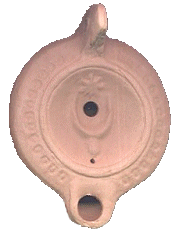 |
LUNA
Circa mid 1st to early 2nd Century AD
The crescent
moon and star suggest this may have been a lamp symbolizing the
goddess Selenus or Luna.
Molded
directly from the original
(about 3.75" by 3")
|

 |
AQUILA
Circa 1st to 3rd Century AD
By popular request- Aquila, a lamp
with a representation of an eagle for the Roman legionaries to light up
their camps. The lamp body is cast from the same original
lamp as the Luna. (about 3.75" by
3")
|

 |
CORINTH
Circa 1st to 3rd Century AD
The discus of this reproduction
Roman lamp features Eros or Cupid, carrying a torch. This cupid is very
similar to
one on an original lamp excavated from Roman period ruins at
Corinth, Greece. The lamp body is cast from the same original
lamp that produced the Luna above.
(about 3.75" by 3")
|

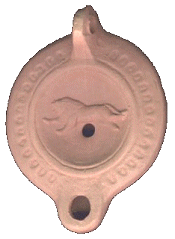 |
LEPTIS MAGNA
Circa
1st to 3rd Century AD
The lion was not
only popular as a figure on its own in Roman
art, but also frequently appeared in conjunction with other Roman
figures
such as Hercules and Cybele. Lions are also often found in scenes with
other animals, usually attacking. This replica Roman lamp has a body
cast directly from the same original
used to create the Luna.
(about
3.75" by 3")
|

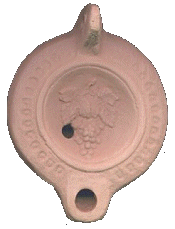 |
OSTIA
Circa 1st to 3rd Century AD
Ostia was the primary port for the
city of Rome, and many amphorae of wine passed through its gates over
the centuries. Grapes were a symbol of
plenty for peoples all over the Roman Empire and the ancient classical
world. They were also closely tied to the Roman god Bacchus, who was
patron
of wine. The body of this replica Roman lamps is cast from the same
original lamp used to make the Luna. (3.75"
by 3")
|

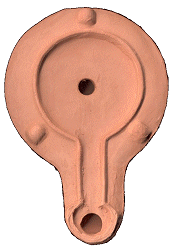 |
FORTIS
Circa late 1st century to 3rd century
AD
A plain firmalampen, this style came into
fashion about AD 70. An original Roman lamp
mold was used to form the base of this lamp. It is utilitarian in
nature, and has no decoration, but was a very common lamp style for
about two centuries. The most prolific maker's mark on these lamps is
"FORTIS", a north Italian maker which apparently sent out molds to
branch lamp makers, but was also widely copied, maker's mark and all.
This lamp carries my own marker's mark, FIGVLI (Literally, "of Figulus"). (about 2.5" x
3.75")
|

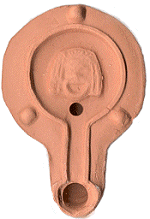 |
VOLTERRA
Circa late 1st century to 3rd century
AD
The city of Volterra, in the
present province of Pisa, is home to a well preserved Roman theater.
This firmalampen features a
theater mask molded directly from
an original lamp (the Plautus, below). The mask is then placed on a
lamp body formed from an impression taken from an original Roman lamp
mold. A northern
Italian lamp type.
(about 2.5" x 3.75")
|

 |
PLAUTUS
Mid 1st century to 2nd century
AD
This theater
mask lamp dates from about AD 50 to sometime in the 2nd
century. Plautus
was a popular Roman playwrite, who penned such
comedies as Miles Gloriosus and Pseudolus (both of which were
adapted into the 1960's A
Funny Thing Happened on the Way to the Forum).
Molded
directly from the original.
(about 4" x
3")
|

 |
BATH
Mid 1st century to 2nd century
AD
Named for
the Roman baths
at Bath,
England, this lamp features Aphrodite
Accroupie
(Venus at the Bath), and uses a body molded directly from the original
above. The image was well known in
the ancient world, and sculpted in marble by such artists as
Praxiteles.
(about 4" x 3")
|

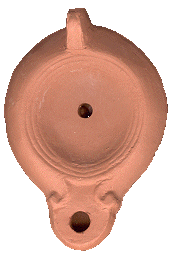 |
MUTINA
Mid 1st century to 2nd century
AD
The body
molded
directly from an original,
this lamp dates to about AD 50 to the 2nd century. A plain utilitarian
style. Mutina is the ancient Roman name for Modena, a major lamp
production center in north-central Italy.
(about 4" x 3")
|
|















